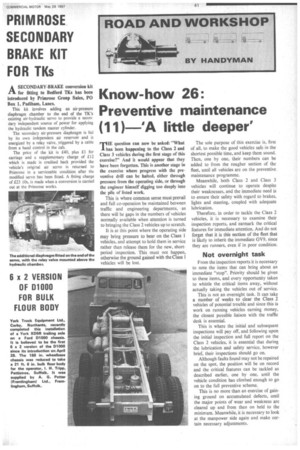Know-how 26: Preventive maintenance (11) 'A little deeper'
Page 43

If you've noticed an error in this article please click here to report it so we can fix it.
question can now be asked: "What has been happening to the Class 2 and Class 3 vehicles during the first stage of this exercise?" And it would appear that they have been forgotten. This is another stage in the exercise where progress with the preventive drill can be halted, either through pressure from the operating side, or through the engineer himself digging too deeply into the pile of listed work.
This is where common sense must prevail and full co-operation be maintained between traffic and engineering departments, as there will be gaps in the numbers of vehicles normally available when attention is turned to bringing the Class 2 vehicles up to scratch.
It is at this point where the operating side may bring pressure to bear on the Class 1 vehicles, and attempt to bold them in service rather than release them for the new, shortperiod inspection. This must not happen, otherwise the ground gained with the Class 1 vehicles will be lost. The sole purpose of this exercise is, first of all, to make the good vehicles safe in the shortest possible time, and keep them sound. Then, one by one, their numbers can be added to from the rougher section of the fleet, until all vehicles are on the preventive maintenance programme.
Meanwhile, both Class 2 and Class 3 vehicles will continue to operate despite their weaknesses, and the immediate need is to ensure their safety with regard to brakes, lights and steering, coupled with adequate lubrication.
Therefore, in order to tackle the Class 2 vehicles, it is necessary to examine their inspection reports, and earmark the critical features for immediate attention. And do not forget that it is this section of the fleet that is likely to inherit the immediate GV9, since they are runners, even if in poor condition.
Not overnight task
From the inspection reports it is necessary to note the items that can bring about an immediate "stop". Priority should be given to these items, and every opportunity taken to whittle the critical items away, without actually taking the vehicles out of service.
This is not an overnight task. It can take a number of weeks to clear the Class 2 vehicles of potential trouble arid since this is work on running vehicles earning money, the closest possible liaison with the traffic desk is essential.
This is where the initial and subsequent inspections will pay off, and following upon the initial inspection and full report on the Class 2 vehicles, it is essential that during the lubrication and safety service, however brief, their inspections should go on.
Although faults found may not be repaired on the spot, the position will be on record and the critical features can be tackled as described earlier, one by one, until the vehicle condition has climbed enough to go on to the full preventive scheme.
This is no more than an exercise of gaining ground on accumulated defects, until the major points of wear and weakness are cleared up and from then on held to the minimum. Meanwhile, it is necessary to look at the manpower side again and make certain necessary adjustments.












































































































